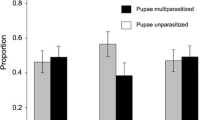Abstract
Interspecific competition within larvae of the fall army worm (FAW), Spodoptera frugiperda (J. E. Smith), by the larval parasitoids, Cotesia (= Apanteles) marginiventris Cresson and Microplitis manilae Ashmead, and the egg-larval parasitoid Chelonus insularis Cresson was studied. Chelonus insularis was not able to compete successfully against Cotesia marginiventris, but was a successful competitor against Microplitis manilae. Multiple parasitization of larvae by either Cotesia marginiventris or Microplitis manilae, which as eggs were parasitized by Chelonus insularis, did not result in additional host mortality. Percentage parasitization under greenhouse conditions by Cotesia marginiventris of larvae parasitized previously by Chelonus insularis was two-fold higher in corn compared to sorghum and more than four-fold higher compared to Bermuda grass and itch grass. The host finding and behavioural sequence of oviposition of Cotesia marginiventris in FAW larvae already parasitized by Chelonus insularis consisted of nine steps. Microplitis manilae females changed their behaviour significantly by displaying a reduction of ca. fifty per cent in host examinations, 45% in ovipositor probes, and 55% in apparent ovipositions when Chelonus insularis parasitized larvae were presented. Cotesia marginiventris and Microplitis manilae exhibited no significant behavioural changes in the per cent contacts, examinations and apparent ovipositions when attacking larvae parasitized previously by either Cotesia marginiventris or Microplitis manilae.
Résumé
Les recherches ont faites sur la compétition entre différentes espèces des Chenilles de la leucanie, le Spodoptera frugiperda (J. E. Smith), par les parasitoides larvaires Cotesia (=Apanteles) marginiventris de Cresson et le Microplitis manilae d’Ashmead, et la parasitoïde Chelonus insularis de Cresson. Le Chelonus insularis n’était pas capable de battre le Cotesia marginiventris, mais il a réussi dans la compétition contre le Microplitis manilae. La vie parasitaire des larves soit par le Cotesia marginiventris ou par le Microplitis manilae, lesquelles ont été déposées en forme d’oeufs par le Chelonus insularis n’a pas abouti à détruire l’hôte. Sous les conditions en serve, le pourcentage des larves parasites déposées par le Cotesia marginiventris par rapport à celles déposées au préalable par le Chelonus insularis était deux fois plus élevé dans le maïs que dans les herbes qui causent des démangeaisons. La quête de l’hôte et la suite de changements comportementaux de la disposition des oeufs du Cotesia marginiventris comprenait neuf stades. Les femelles du Microplitis manilae ont beaucoup changé leur comportement en déployant une réduction du calcium. Cinquante pour cent dans l’examen de l’hôte, 45% dans la manière de déposer les oeufs, et 55% dans les dépôts apparents d’oeufs quand on mettait en leur présence des larves parasites Chelonus insularis. Le Cotesia marginiventris et le Microplitis manilae ne montraient pas de changements comportementaux en pour cent dans les domaines de contacts, d’examens et de dépôts apparents d’oeufs au moment d’attaquer des larves parasites déposées préalablement soit par le Cotesia marginiventris ou par le Microplitis manilae.
Similar content being viewed by others
References
Ashley T. R. (1979) Classification and distribution of fall army worm parasites. Fla. Entomol. 62, 114–123.
Ashley T. R., Waddil V. H., Mitchell E. R. and Rye J. (1982) Impact of native parasites on the fall armyworm, Spodoptera frugiperda (Lepidoptera: Noctuidae) in South Florida and the release of the exotic parasite, Eiphosoma vinicole (Hymenoptera: Ichneumonidae). Environ. Entomol. 11, 833–837.
Ashley T. R., Barfield C. S., Waddill V. H. and Mitchell E. R. (1983) Parasitization of fall armyworm larvae on volunteer corn, Bermuda grass, and paragrass. Fla. Entomol. 66, 267–277.
Boiler E. F. and Chamers D. L. (1977) Quality aspects of mass reared insects. In Biological Control by Augmentation of Natural Enemies (Edited by Ridgeway R. L. and Vinson S. B.), pp. 219–236. Plenum Press, New York.
eckage N. E. (1982) Incomplete host development induced by parasitism of Manduca sexta larvae by Apanteles smerinthi. Ann. Entomol. Soc. Am. 75, 24–27.
Force D. C. (1974) Ecology of insect host-parasitoid communities. Science 184, 624–632.
Leppla N. C., Vail P. and Rye J. R. (1979) Mass rearing and handling of the cabbage looper. Proceedings FAOIIAEA Training Course on Use of Radiosotopes and Radiation in Entomology, Univ. Fla. 95–6. pp. 59–75.
Loke W. H., Ashley T. R. and Sailer R. I. (1983) Influence of fall armyworm Spodoptera frugiperda (Lepidoptera: Noctuidae) larvae and corn plant damage on host finding in Apanteles marginiventris (Hymenoptera: Braconidae). Environ. Entomol. 12, 911–915.
Luginbill P. (1928) The fall armyworm. U. S. Dept. Agric. Tech. Bull. 34, 1–92.
Miller J. C. (1982) Life history of insect parasitoids in successful multiparasitism. Oecologia 54, 8–9.
Mitchell E. R. (1979) Fall Armyworm Symposium, preface. Fla. Entomol. 62, 81.
Salt G. (1961) Competition among insect parasitoids. In Mechanisms in Biological Competition. Proceedings Symposium S oc. Exp. Biol. 15, 96–119.
Steel R. G. D. and Torrie J. H. (1960) Principal and Procedures of Statistics. McGraw-Hill Book Company, Inc., New York.
Vinson S. B. and Iwantsch G. F. (1980) Host suitability for insect parasitoids. Annu. Rev. Entomol. 25, 397–419.
Weseloh R. M. (1983) Effects of multiple parasitism on the gypsy moth parasite Apanteles melanoscelus (Hymenoptera: Braconidae) and Compsilura concinnata (Diptera: Tachinidae). Environ. Entomol. 12, 599–602.
Author information
Authors and Affiliations
Rights and permissions
About this article
Cite this article
Rajapakse, R.H.S., Ashley, T.R. & Waddill, H. Interspecific Competition Between Parasitoids of the Fall Armyworm, Spodoptera Frugiperda (J. E. Smith) (Lepidoptera: Noctuidae). Int J Trop Insect Sci 12, 473–480 (1991). https://doi.org/10.1017/S1742758400011383
Received:
Revised:
Published:
Issue Date:
DOI: https://doi.org/10.1017/S1742758400011383




